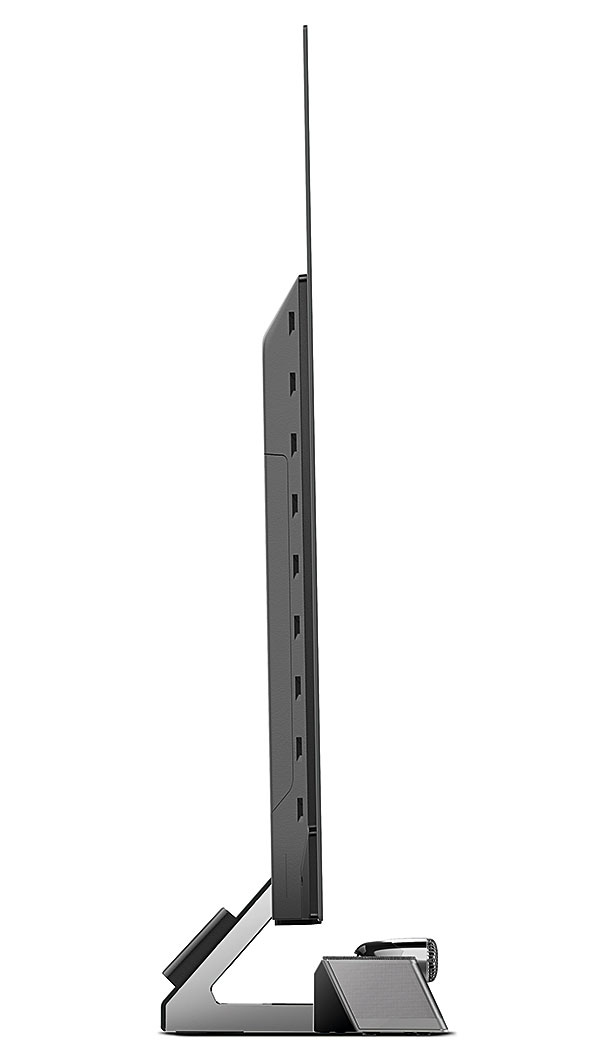Philips 65OLED+936 OLED TV Review

 Advanced AI, the latest panel tech and a sound system to die for – this TV is a winner, say Steve May
Advanced AI, the latest panel tech and a sound system to die for – this TV is a winner, say Steve May
Philips is aiming for the front of the grid with the 65OLED+936. An evolution of the brand's OLED+935 model, this update couples a racy fifth-generation P5 image engine with an all-new OLED panel and HDMI 2.1 high frame rate support. The screen has clearly got Panasonic's JZ2000 home cinema hero in its sights, so what can it tempt us with? Quite a lot, as it happens...
Firstly, this new range-topper lauds it over the brand's OLED806 series (although doesn't go as large as that model's 77in, keeping screen sizes to 55in and 65in) with a premium steel frame and neatly integrated Bowers & Wilkins Dolby Atmos sound system, graced with the audio corp's distinctive Tweeter-on-Top.
Boffins at B&W groan when we describe this audio armoury as a soundbar, but that's what it looks like. An aluminium micro-mesh grille protects forward-facing drivers, while a grey Kvadrat cloth rooftop hides upfiring units (a reversal of what we've seen before, which, says B&W, negates unwanted reflections).
There have been significant changes to the sound system internally too, with adjustments to the crossover components, improved voice coils for the four mid-range drivers, and new surrounds for all three tweeters. B&W has also implemented a somewhat stiffer and new profile 100mm x 65mm bass driver, with a more powerful magnet.
The Atmos elevation units have also been repositioned, and there's been an upgrade to the Dolby Multistream decoder, too. Still a 3.1.2 configuration, the most obvious characteristic is just how big, even epic, this system sounds. The fly-on- the-wall documentary Formula 1: Drive to Survive (Netflix, Dolby Atmos) has a soundtrack propelled by pounding rhythms and engine roars that scoot across the front soundstage. There's also continual narration. It's a perfect sonic sandpit for this TV.
Audio licks at the extremities of my viewing room, but crisp dialogue is locked to the centre of the screen. It's a wall of sound as impressive as the ancient stonework that frames the street race in Azerbaijan. When a helicopter takes off before the Baku Grand Prix, it genuinely seems to track up and out of the room.

Power is rated at 70W, and this soundbar plays loud. Presets to explore include AI Mode (which runs automatic surround optimisation by Dolby), Original, Movie, Music, Game, Dialogue and Personal.
Away from audio, the OLED+936 – like the OLED806 range [HCC #323] – introduces big changes on the input front. The TV sports four HDMIs, of which two are full-bandwidth 48Gbps-capable connections able to accept 4K HFR video at 120Hz from a PS5, Xbox Series X or compatible PC.
There's also wide-ranging Variable Refresh Rate support (Nvidia G-Sync, AMD FreeSync Premium Pro, and HDMI Forum VRR), plus ALLM. All four HDMI inputs are ARC compatible, with HDMI 2 upgraded to eARC.
Fifth Time's A Charm
Processing on the OLED+936 is handled by a fifth iteration of Philips' highly regarded P5 picture engine, here in AI Intelligent Dual Picture Engine guise. Among improvements offered are the ability to measure and react to ambient room light, using Ambient Intelligence, and a new Film Detection mode which offers the opportunity to automatically view with Filmmaker Mode (no content flag required) or an all-new Home Cinema preset. You can set your preference in the menu system.
Top marks should go to this Home Cinema setting. Going against the conventional wisdom of such presets, it offers cool whites, high contrast and a vibrant colour palette, but no overt motion nasties. As a halfway house between Filmmaker Mode and the indecent richness of Vivid, I really like it.
As we've come to expect from Philips, HDR support is extensive. Both Dolby Vision and HDR10+ dynamic metadata standards are accommodated, alongside HLG, regular HDR10, and game-specific HGiG HDR.
The brand has chosen not to implement Dolby Vision IQ, instead relying on its aforementioned sensor technology. This makes real-time adjustments to the set's contrast algorithms based on ambient room lighting, and you can see this in action when you select the Dolby Vision Bright option (my preferred preset). Other Dolby Vision picture modes include Personal, Vivid, Dark and Game.
Similarly, HDR10+ Adaptive combines dynamic metadata adjustment with ambient light measurement, enabling brightness levels to be optimised without impacting overall darkness. This is mainly useful for Prime Video subscribers.
To make life a little easier for those who have struggled to negotiate Philips' user options, Filmmaker Mode finally becomes Filmmaker Mode in the picture settings menu. Previously, features of Filmmaker Mode were subsumed under Philips' SDR and HDR Movie presets.
Gamers need to be aware that latency is good but not outstanding. I measured input lag at 21.6ms in Game mode (1080/60) – a lower figure than on the step-down OLED806, because this model incurs a minor timing penalty due to its P5 Dual Engine processing configuration.
 |
Home Cinema Choice #351 is on sale now, featuring: Samsung S95D flagship OLED TV; Ascendo loudspeakers; Pioneer VSA-LX805 AV receiver; UST projector roundup; 2024’s summer movies; Conan 4K; and more
|

















































